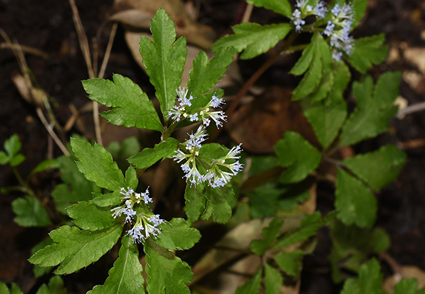Abstract
Based on observations on living plants in field, together with examination of herbarium specimens (including type material), we demonstrate that Sanicula orthacantha var. orthacantha (Apiaceae) differs from S. orthacantha var. brevispina only by the rhizome short, oblique rootstock bearing elongated, fibrous roots, sometimes fleshy stoloniferous (vs. slender, elongate and lignified nodes stoloniferous). In addition, S. petagnioides is found to be identical with S. orthacantha var. orthacantha, and S. orthacantha var. stolonifera is found to be identical with S. orthacantha var. brevispina, we therefore synonymized herein respectively. Lectotypification is proposed for S. petagnioides, S. orthacantha var. stolonifera.
References
Boissieu, H. de (1906) Note sur quelques Ombellifères de la Chine, d’après les collections du Muséum d’Histoire naturelle de Paris. Bulletin de la Société Botanique de France 53: 418–437. https://doi.org/10.1080/00378941.1906.10831189
Diels, L. (1901) Die Flora von Central-China (Schluss). Botanische Jahrbücher fur Systematik, Pflanzengeschichte und Pflanzengeographie 29: 577–659.
Forbes, F.B. & Hemsley, W.B. (1886–1888) An Enumeration of all the Plants known from China Proper, Formosa, Hainan, Corea, the Luchu Archipelago, and the Island of Hongkong, together with their Distribution and Synonymy. The Journal of The Linnean Society 23: 1–489. https://doi.org/10.1111/j.1095-8339.1886.tb00530.x
Fu, K.T. (1981) Sanicula L. In: Anonymous (Ed.) Flora Tsinlingensis, Tomus I. Science Press, Beijing, pp. 374–377.
Hance, H.F. (1878) Spicilegia florae sinensis: Diagnoses of new and habitats of rare or hitherto unrecorded, Chinese plants. Journal of Botany, British and Foreign 16: 6–15.
Handel-Mazzetti, H.F. (1933) Symbolae Sinicae, vol. 7 (3). Julius Springer, Vienna, pp. 706–730.
Hayata, B. (1908) Flora Montana Formosæ: An Enumeration of the Plants Found on Mt. Morrison, the Central Chain, and Other Mountainous Regions of Formosa at Altitudes of 3,000-13,000 Ft. Journal of the College of Science, Imperial University of Tokyo 25 (19): 1–260. https://doi.org/10.5962/bhl.title.10880
Hiroe, M. (1979) Umbelliferae of World. Ariake Book Company, Matsuo Biru, Tokyo, 2128 pp.
Li, H.M. & Song, C.F. (2022) Taxonomic studies on the genus Sanicula (Apiaceae) from China (I): The identity of S. orthacantha var. pumila and S. pengshuiensis. Phytotaxa 532 (2): 1141–138. https://doi.org/10.11646/phytotaxa.532.2.1
Linnaeus, C. (1753) Species Plantarum. Laurentii Salvii, Holmiae. 1200 pp.
Liou, S.L. (1979) Sanicula L. In: Shan, R.H. & Sheh, M.L. (Eds.) Flora Reipublicae Popularis Sinicae, vol. 55 (1). Science Press, Beijing, pp. 35–63.
Liu, S.L. (1997) Sanicula L. In: Wu, Z.Y. (Ed.) Flora Yunnanica, vol. 7. Science Press, Beijing, pp. 372–380.
Maximowicz, C.J. (1859) Primitiae florae Amurensis. Versuch einer Flora des Amurlandes. Mit 10 Tafeln und einer Karte. Memoires Presentes a l’Academie Imperiale des Sciences de St.-Petersbourg par Divers Savans et lus dans ses Assemblees 9: 1–504.
Maximowicz, C.J. (1867) Diagnoses breves plantarum novarum Japoniae et Mandshuriae. Bulletin de l’Academie Imperiale des Sciences de St.-Petersbourg 11: 429–432. https://doi.org/10.5962/bhl.title.46306
Maximowicz, C.J. (1886) Diagnoses de Nouvelles plantes de I’Asie. VI. Bulletin de l’Academie Imperiale des Sciences de St.-Petersbourg 3 (32): 12–121.
McNeill, J. (2014) Holotype specimens and type citations: general issues. Taxon 63: 1112–1113. https://doi.org/10.12705/635.7
Moore, S. (1875) Description of some new phanerogamia collected by Dr. Shearer, at Kiukiang. China. Journal of Botany, British and Foreign 13: 225–231.
Pimenov, M.G. (2017) Updated checklist of Chinese Umbelliferae: Nomenclature, Synonymy, Typification, Distribution. Turczaninowia 20: 106–239. https://doi.org/10.14258/turczaninowia.20.2.9
Shan, R.H. & Constance, L. (1951) The Genus Sanicula (Umbelliferae) in the Old World and the New. University of California Publications in Botany 25: 1–78.
Shan, R.H. (1943) Umbelliferae Novae Sinicae. Sinensia 14: 111–114.
Sheh, M.L. & Phillippe, L.R. (2005) Sanicula L. In: Wu, Z.Y., Raven, P.H. & Hong, D.Y. (Eds.) Flora of China, vol. 14. Science Press & Missouri Botanical Garden Press, Beijing & St. Louis, pp. 19–24.
Turland, N.J., Wiersema, J.H., Barrie, F.R., Greuter, W., Hawksworth, D.L., Herendeen, P.S., Knapp, S., Kusber, W.-H., Li, D.-Z., Marhold, K., May, T.W., McNeill, J., Monro, A.M., Prado, J., Price, M.J. & Smith, G.F. (2018) International Code of Nomenclature for algae, fungi, and plants (Shenzhen Code). Regnum Vegetabile 159. Koeltz Botanical Books, Glashütten, 254 pp. https://doi.org/10.12705/Code.2018
Wang, W.T. (1993) Vascular Plants of the Hengduan Mountains, vol. 1. Science Press, Beijing, 1363 pp.
Wolff, H. (1913) Umbelliferae-Saniculoideae. In: Engler, A. (Ed.) Das Pflanzenreich, vol. 4. Wilhelm Engelmann, Leipzig & Berlin, pp. 1–305.
Wu, C.Y. (1984) Index Florae Yunnanensis, vol. 1. Yunnan People’s Publishing House, Kunming, 1070 pp.
Yang, M.Z. (1989) Sanicula L. In: Anonymous (Ed.) Flora Guizhouensis, Tomus 4. Guizhou People’s Publishing House, Guiyang, pp. 360–367.


